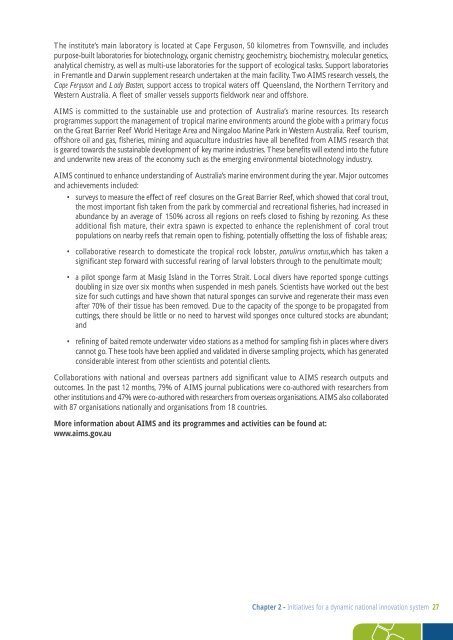The Australian Government's Innovation Report
The Australian Government's Innovation Report
The Australian Government's Innovation Report
You also want an ePaper? Increase the reach of your titles
YUMPU automatically turns print PDFs into web optimized ePapers that Google loves.
<strong>The</strong> institute’s main laboratory is located at Cape Ferguson, 50 kilometres from Townsville, and includes<br />
purpose-built laboratories for biotechnology, organic chemistry, geochemistry, biochemistry, molecular genetics,<br />
analytical chemistry, as well as multi-use laboratories for the support of ecological tasks. Support laboratories<br />
in Fremantle and Darwin supplement research undertaken at the main facility. Two AIMS research vessels, the<br />
Cape Ferguson and Lady Basten, support access to tropical waters off Queensland, the Northern Territory and<br />
Western Australia. A fleet of smaller vessels supports fieldwork near and offshore.<br />
AIMS is committed to the sustainable use and protection of Australia’s marine resources. Its research<br />
programmes support the management of tropical marine environments around the globe with a primary focus<br />
on the Great Barrier Reef World Heritage Area and Ningaloo Marine Park in Western Australia. Reef tourism,<br />
offshore oil and gas, fisheries, mining and aquaculture industries have all benefited from AIMS research that<br />
is geared towards the sustainable development of key marine industries. <strong>The</strong>se benefits will extend into the future<br />
and underwrite new areas of the economy such as the emerging environmental biotechnology industry.<br />
AIMS continued to enhance understanding of Australia’s marine environment during the year. Major outcomes<br />
and achievements included:<br />
• surveys to measure the effect of reef closures on the Great Barrier Reef, which showed that coral trout,<br />
the most important fish taken from the park by commercial and recreational fisheries, had increased in<br />
abundance by an average of 150% across all regions on reefs closed to fishing by rezoning. As these<br />
additional fish mature, their extra spawn is expected to enhance the replenishment of coral trout<br />
populations on nearby reefs that remain open to fishing, potentially offsetting the loss of fishable areas;<br />
• collaborative research to domesticate the tropical rock lobster, panulirus ornatus,which has taken a<br />
significant step forward with successful rearing of larval lobsters through to the penultimate moult;<br />
• a pilot sponge farm at Masig Island in the Torres Strait. Local divers have reported sponge cuttings<br />
doubling in size over six months when suspended in mesh panels. Scientists have worked out the best<br />
size for such cuttings and have shown that natural sponges can survive and regenerate their mass even<br />
after 70% of their tissue has been removed. Due to the capacity of the sponge to be propagated from<br />
cuttings, there should be little or no need to harvest wild sponges once cultured stocks are abundant;<br />
and<br />
• refining of baited remote underwater video stations as a method for sampling fish in places where divers<br />
cannot go. <strong>The</strong>se tools have been applied and validated in diverse sampling projects, which has generated<br />
considerable interest from other scientists and potential clients.<br />
Collaborations with national and overseas partners add significant value to AIMS research outputs and<br />
outcomes. In the past 12 months, 79% of AIMS journal publications were co-authored with researchers from<br />
other institutions and 47% were co-authored with researchers from overseas organisations. AIMS also collaborated<br />
with 87 organisations nationally and organisations from 18 countries.<br />
More information about AIMS and its programmes and activities can be found at:<br />
www.aims.gov.au<br />
Chapter 2 - Initiatives for a dynamic national innovation system 27












![[Tam] Uygula[ya] - Bilim, Teknoloji ve Ä°novasyon Politikaları TartıÅma ...](https://img.yumpu.com/36820041/1/184x260/tam-uygulaya-bilim-teknoloji-ve-anovasyon-politikalara-tartaama-.jpg?quality=85)



